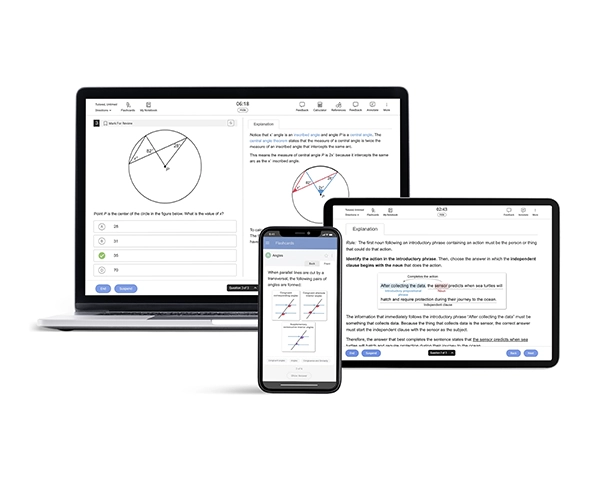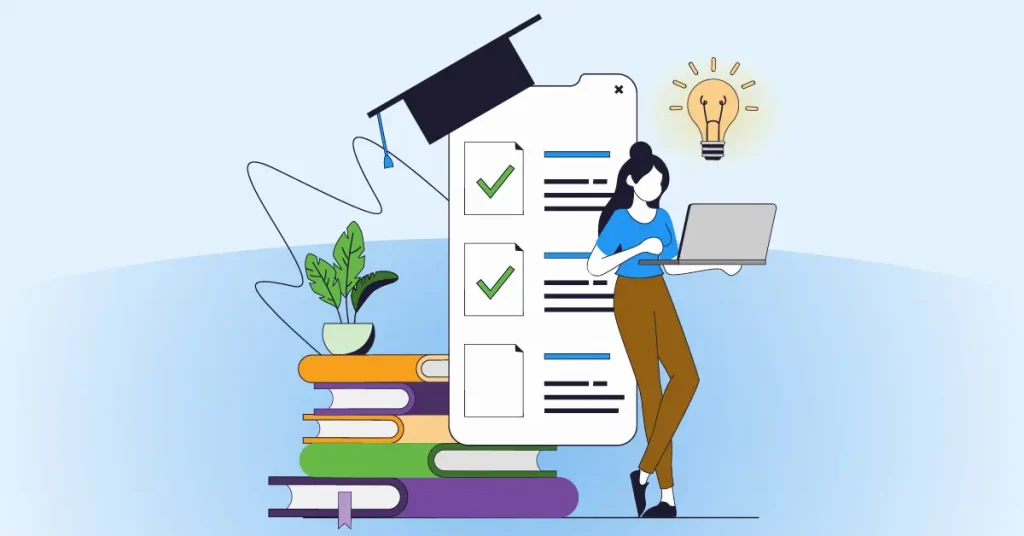The first step to any SAT self-study plan should be to take a timed, full-length practice SAT from the College Board®. This score will provide a baseline from which you can begin setting goals and creating a study plan. You can skip this step if you already have a score from a recently taken SAT. Your score will tell you which sections and question types you are struggling with and on what topics require additional focus.
Now it’s time to gather your study resources. Tutors are an option, but you will certainly need high-quality resources that offer comprehensive material and sufficient exam-level practice questions.
Full-length practice tests are a must for any diligent student. Fortunately, UWorld offers three full-length practice tests in addition to our SAT question bank. These tools will help you identify your weaknesses and become familiar with the test format. Not understanding something? No problem. Every answer choice is accompanied by in-depth answer explanations written by subject matter experts.
You’ll also need a reliable calculator1. Make sure your desired model is allowed per the SAT’s calculator policy. Whichever calculator you choose, practicing with it will save you time on exam day.
If possible, start preparing at least three months before your SAT exam date. We recommend setting aside 20-30 minutes a day, 2-3 days a week, and focusing on one exam section per session. Reflect on your approach to each question—analysis improves consistency.
Set aside 3–4 hours for a timed, full-length test at the beginning of your test prep journey, then continue to take a practice test every month, taking a final full-length test two weeks before exam day. This practice serves two purposes:
- Progress-monitoring to see which content areas have improved and which still need work
- Practice time management so you’ll be used to exam time restrictions on test day
Additionally, you’ll also want to take 15 minutes at the end of each week to check data reports and gauge the progress you’ve made with general practice questions. This will help you see which content areas need more focus so you can adjust the following week’s study plan.
Here are some tips on how to stick to your schedule:
- Dedicate a study space and set a routine
Studying around other students can help simulate test day conditions, but most of your review should be done somewhere quiet with an atmosphere that helps you focus. Schedule these sessions regularly to form strong habits and avoid burnout. - Join or start a study group
Constant self-study can get lonely. Study groups provide the opportunity to discuss common concerns and trade useful strategies. Having a group of people to lean on can also keep you motivated and reduce stress. Perhaps most importantly, teaching others is a proven way to increase retention. - Register for a test date
Registering for a test gives you a deadline, which will help you organize your schedule and keep you on track. Give yourself enough time to avoid cramming, but keep in mind that you may feel overly secure and lose motivation if you give yourself too much time.
How to create the ultimate SAT study plan on your own
It’s important to strike a healthy balance between study and practice. Memorization and understanding are one thing, but applying knowledge and reason on exam day is another. Here’s how to create your personal ultimate SAT study plan2.
What are some tips for staying motivated while self-studying for the SAT?
Without the structure of a classroom, the incentives provided by regular grades, and the camaraderie of fellow students, many high schoolers find it more difficult to remain motivated while studying for the SAT than while studying for any other class.
Creating comparable structures and incentives on your own goes a long way in keeping your motivation high. Establish a clear study schedule that includes a diagnostic test or two every month; your performance on these tests provides a way to grade your progress and prove how worthwhile your studies have been. It's much easier to stick to a study regimen when you don't have to wait till test day to know whether your work is paying off.
You can further capitalize on the motivating power of these diagnostic tests by researching the average accepted SAT scores of each of your dream schools. Aiming for a "good" score is too vague to motivate most students, but with a specific number in mind, your diagnostic scores become visual milestones on your path to college acceptance.
Finally, find a study buddy, a friend, or a mentor who can hold you accountable. Studies consistently show that habits are most consistently maintained by those who share their goals with friends or accountability partners.
What are the best resources for self-studying for the SAT?
The first resource every SAT self-study plan should utilize is a timed, full-length practice exam3. The corresponding score will provide a baseline from which you can begin setting goals and creating a study plan. Your score will tell you which sections and question types you are struggling with and need to focus on.
In terms of day-to-day practice, however, the most important quality to seek out in a resource is test similarity. No product without sufficient numbers of test-like questions can truly prepare you to take the exam. While tutors, video courses, and books are all viable options, it's essential to ensure that the books you choose are among the best SAT books for self-study. These books should typically offer comprehensive material and sufficient exam-level practice questions, making them invaluable resources for your independent study.
Of course, content gaps must be addressed, so the best resources will pair those practice questions with in-depth answer explanations. UWorld's content experts provide comprehensive explanations for every answer choice of every question in our SAT question bank, covering not only the material being tested but also test strategies and tips for approaching similar questions.
How can I assess my progress while self-studying for the SAT?
Diagnostic tests are a must. During your SAT self-study course, take a full-length, timed practice test at least once a month (two to three times if you've been studying for three months or less). Taking these tests under exam conditions will improve their accuracy.
Your scores on these diagnostic tests will benchmark your progress in individual sections and on the overall exam.
Are there any common mistakes students make when self-studying for the SAT?
The mistakes made by self-studiers on the Digital SAT align with the mistakes students make while studying in general.
Students who study without the context of the actual exam—for example, by reading textbooks or watching videos without practicing the kinds of questions they'll see on test day—often find themselves assuming they've improved without any measurable increase in skill.
On the other hand, students who answer question after question without deeply reviewing their work often find themselves plateauing in score. Such practice might increase familiarity and comfort with the test, but it does little to refine strategies or fill in content gaps.
Both of these errors are solved by practicing with a resource that pairs exam-like questions with comprehensive explanations, which, when carefully considered, guide students to form their own best strategies and practices for answering any given question.
Can you improve your SAT scores with self study?
The SAT is a college readiness test, not an intelligence test. Studying independently can improve your readiness by filling in content gaps and increasing your comfort with how that content is tested on the exam. If you study effectively, as described in this article, you are certain to see improvement in your SAT scores.
What are the benefits of self-studying for the SAT compared to working with a tutor?
Most obviously, self-study is less expensive than regular sessions with a private tutor, which can cost hundreds or thousands of dollars over the course of a full study plan.
Beyond the cost, self-study is more predictably reliable. The degree to which any given tutor will be able to help any given student is somewhat dependent on their respective teaching and learning styles, some of which align much better than others. Meanwhile, every student will benefit similarly from consistent, careful self-study of exam-like questions.
Furthermore, tutors are likely to lean on many of the same resources as self-studiers. Practice questions and diagnostic tests are undeniably essential to the study process, to the point that they take precedence even under direct instruction.

References
1(2024). Calculator Rules. SAT Calculator Policy. Retrieved on March 01, 2024 from https://satsuite.collegeboard.org/sat/what-to-bring-do/calculator-policy
2(2024). How to use your prep time most effectively. Creating an SAT prep plan. Khan Academy. Retrieved on March 01, 2024 from
https://www.khanacademy.org/test-prep/sat-reading-and-writing/x0d47bcec73eb6c4b:about-the-sat/x0d47bcec73eb6c4b:preparing-for-the-sat/a/creating-an-sat-prep-plan
3(August 26, 2019). Take a Full-Length Practice Test and Review Your Results. Take a Full-Length Practice Test and Review Your Results. College Board. Retrieved on March 01, 2024 from
https://blog.collegeboard.org/what-best-way-prepare-digital-sat



